
Concept explainers
Two small disks A and B of mass 2 kg and 1 kg, respectively, may slide on a horizontal and frictionless surface. They are connected by a cord of negligible mass and spin about their mass center G. At t = 0, G is moving with the velocity

(a)
The initial velocity,
Answer to Problem 14.54P
Explanation of Solution
Given information:
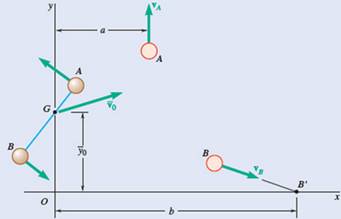
Mass of the disk A,
Mass of the disk B,
At t=0,
Co-ordinates of G are
Velocity of A,
Velocity,
Distance
Firstly, calculate for initial condition:
The free body diagram for initial condition is as follows:
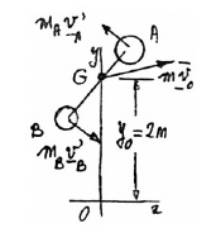
The distance G from points A and B,
And,
Now, considering linear momentum,
Hence, angular momentum of both the disc about G,
Now, kinetic energy of the component is,
Calculation:
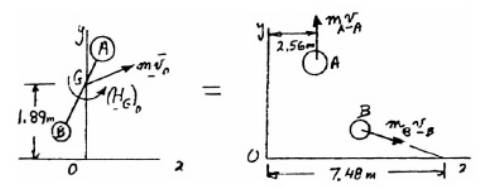
Using conservation of mass of linear momentum,
(b)
The length of cord initially connecting the two disks.
Answer to Problem 14.54P
Explanation of Solution
Given information:
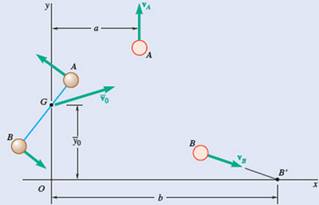
Mass of the disk A,
Mass of the disk B,
At t=0,
Co-ordinates of G are
Velocity of A,
Velocity,
Distance
Firstly, calculate for initial condition:
The free body diagram for initial condition is as follows:

The distance G from points A and B,
And,
Now, considering linear momentum,
Hence, angular momentum of both the disc about G,
Now, kinetic energy of the component is,
Calculation:
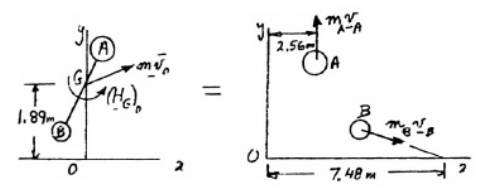
Using conservation of mass of linear momentum,
Conservation of angular momentum of both the disc about point O,
Now, applying law of conservation of energy:
Dividing equation (2) by equation (1);
Now, substituting the value of ? in equation (1);
(c)
The rate in rad/s at which the disks were spinning about G.
Answer to Problem 14.54P
Explanation of Solution
Given information:
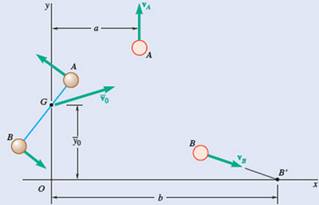
Mass of the disk A,
Mass of the disk B,
At t=0,
Co-ordinates of G are
Velocity of A,
Velocity,
Distance
Firstly, calculate for initial condition:
The free body diagram for initial condition is as follows:

The distance G from points A and B,
And,
Now, considering linear momentum,
Hence, angular momentum of both the disc about G,
Now, kinetic energy of the component is,
Calculation:
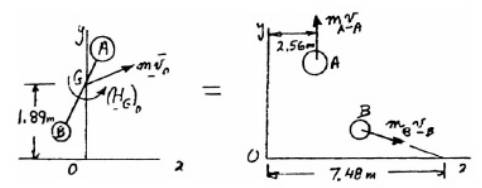
Using conservation of mass of linear momentum,
Conservation of angular momentum of both the disc about point O,
Now, applying law of conservation of energy:
Dividing equation (2) by equation (1);
Want to see more full solutions like this?
Chapter 14 Solutions
Vector Mechanics For Engineers
- A 30-kg disk A is attached to one end of a spring with stiffness k = 200 N/m at its center G. The other end of the spring is fixed at A. The disk is initially at rest with the spring unstretched. A couple moment of M = 80 Nm is then applied to the disk causing the disk to roll to the left without sliding. Consider the duration of motion when the disk rolls from the position shown (Position 1) to a position (Position 2) when its mass center G has moved 0.5 m to the left. M = 80 N·m 1.875w2^2 3.75w2^2 5.63w2^2 7.50w2^2 0.5 m G k = 200 N/m A 1. Which of the following forces do/does negative work on the disk? I. Applied couple II. Force exerted by the spring III. Normal force IV. Friction between the disk and the horizontal surface 2. Which of the following equations gives the total kinetic energy of the disk at position 2 in terms of its angular velocity, w2? Oarrow_forwardThe sphere of mass m1 = 5 kg falls from a height H = 1.4 m onto the homogeneous board of negligible mass. The board can rotate about a horizontal axis passing through point O, and a body of mass m2 = 3.1 kg is placed on it at a distance b = 1 m from the axis of rotation. The collision is perfectly inelastic. How high does the body of mass m2 rise after the collision (in m) if a = 0.7 m?arrow_forwardRequired information NOTE: This is a multi-part question. Once an answer is submitted, you will be unable to return to this part. Two small disks A and B of mass 3 kg and 1.5 kg, respectively, may slide on a horizontal, frictionless surface. They are connected by a cord 600 mm long and spin counterclockwise about their mass center G at the rate of 13 rad/s. At t = O, the coordinates of G are x = 0 and yo= 2 m, and its velocity is Vo= (1.2 m/s)i +(0.96 m/s)j. Shortly thereafter, the cord breaks; disk A is then observed to move along a path parallel to the yaxis and disk B along a path which intersects the x axis at a distance b-7.5 m from O. Determine the distance a from the y axis to the path of A. The distance from the y axis to the path of A is m. B'arrow_forward
- The sphere of mass m1 = 5 kg falls from a height H = 1.4 m onto the homogeneous board of negligible mass. The board can rotate around a horizontal axis passing through point O, and a body of mass m2 = 3.9 kg is placed on it at a distance b = 1 m from the axis of rotation. The collision is perfectly inelastic. How high does the body of mass m2 rise after the collision (in m) if a = 0.5 m?arrow_forwardJourney through the Center of the Earth. A 1024-kg blue ball is dropped from an initial z-position of 2.3 x 106 m through the center of a planet with radius 7.6 x 106 m. If the mass of the planet is 33.9 x 1015 kg, measure the displacement of the ball at time t = 9 s?arrow_forwardObject A, mass 12 kg, is attached to a pulley with mass 15 kg and a radius of 0.25 m. The pulley is rotating at 2000 rpm. If object A is to be reduced to half its initial speed, plant By braking the pulley bearings which creates a moment of resistance of 800 N-m. I want to know how far the object will slide down and what is the tension in the rope at that time. 12 kg 0.3 marrow_forward
- b 4 k m 36 4 A b 4 B The uniform slender bar of mass 3.0 kg pivots freely about a horizontal axis through O. If the bar is released from rest in the horizontal position shown where the spring is unstretched, it is observed to rotate a maximum of 42° clockwise. The spring constant k = 230 N/m and the distance b = 0.3 m. Determine the total work done on the bar.arrow_forwardNOTE: This is a multi-part question. Once an answer is submitted, you will be unable to return to this part. Two small disks A and B of mass 3 kg and 1.5 kg, respectively, may slide on a horizontal, frictionless surface. They are connected by a cord 600 mm long and spin counterclockwise about their mass center Gat the rate of 15 rad/s. At t= O, the coordinates of Gare x = 0 and yo = 2 m, and its velocity is v0 = (1.2 m/s)i +(0.96 m/s)j. Shortly thereafter, the cord breaks; disk A is then observed to move along a path parallel to the yaxis and disk Balong a path which intersects the x axis at a distance b=7.5 m from O. B C yo B B' x Determine the velocities of A and B after the cord breaks. (You must provide an answer before moving on to the next part.) 3.3 After the cord breaks, the velocity of A is After the cord breaks, the velocity of Bis 5.13 m/s↑. m/s € 45.4arrow_forwardThe satellite shown in the figure below has a mass of 250 kg. In its initial configuration, when e = 90°, its radius of gyration around its z-axis is kz= 0.7 m. Att= 0s, the solar panels are raised in such a way that the radius of gyration decreases at a constant rate of 0.05 ms. Assume its mass stays constant during this motion. В 0 = 90° A 0.2 m 1.5 m 0.3 m Suppose the angular velocity around the z-axis of the satellite att = Os equals wz = 2.2 rads, what is the magnitude of the satellite's angular acceleration, angular velocity and angular displacement (around the z-axis) at at t= 3 s?arrow_forward
- In a satellite model for a science project, given the masses of the three satellites m=1.8 kg, mg= 4 kg, and m.=5 kg that are connected with massless rods, joined at the point the rotation axis is passing through. The satellites have the distances rad R=1.5 m, R = 1 m, and Rc=2 m, from the rotation axis. The system rotates with an angular speed w = 2.7 mA RA RB RC mc 1. Calculate the moment of inertia I; for this model: /, = kg m2 m2 kg 2. Calculate the magnitude of the angular momentum L, = 3. Calculate the rotational kinetic energy K, = J 4. As the system is rotating counter-clockwise the direction of the vector is The mass mc was not properly glued and breaks away during the rotation. 1. Calculate the moment of inertia /f for this model now. If= |kg m2 2. Using the conservation of angular momentum, calculate the angular speed wf after the mass m, has broken away during rad the rotation. Wf= 3. Calculate the rotational kinetic energy in this situation: K=arrow_forwardA 1024-kg blue ball is dropped from an initial z-position of 5.4 x 106 m through the center of a planet with radius 6.3 x 106 m. If the mass of the planet is 37.7 x 1015 kg, measure the displacement of the ball at time t = 5 s?arrow_forwardConsider a slender rod AB with a length l and a mass m. The ends are connected to blocks of negligible mass sliding along horizontal and vertical tracks. If the rod is released with no initial velocity from a horizontal position as shown in Fig.A, determine its angular velocity after it has rotated through an angle of θ (see Fig B) using the conservation of energy method. (Hint: Moment of inertia of rod about G = (1/12)ml2 The kinetic energy of a rigid body in plane motion isarrow_forward
 Elements Of ElectromagneticsMechanical EngineeringISBN:9780190698614Author:Sadiku, Matthew N. O.Publisher:Oxford University Press
Elements Of ElectromagneticsMechanical EngineeringISBN:9780190698614Author:Sadiku, Matthew N. O.Publisher:Oxford University Press Mechanics of Materials (10th Edition)Mechanical EngineeringISBN:9780134319650Author:Russell C. HibbelerPublisher:PEARSON
Mechanics of Materials (10th Edition)Mechanical EngineeringISBN:9780134319650Author:Russell C. HibbelerPublisher:PEARSON Thermodynamics: An Engineering ApproachMechanical EngineeringISBN:9781259822674Author:Yunus A. Cengel Dr., Michael A. BolesPublisher:McGraw-Hill Education
Thermodynamics: An Engineering ApproachMechanical EngineeringISBN:9781259822674Author:Yunus A. Cengel Dr., Michael A. BolesPublisher:McGraw-Hill Education Control Systems EngineeringMechanical EngineeringISBN:9781118170519Author:Norman S. NisePublisher:WILEY
Control Systems EngineeringMechanical EngineeringISBN:9781118170519Author:Norman S. NisePublisher:WILEY Mechanics of Materials (MindTap Course List)Mechanical EngineeringISBN:9781337093347Author:Barry J. Goodno, James M. GerePublisher:Cengage Learning
Mechanics of Materials (MindTap Course List)Mechanical EngineeringISBN:9781337093347Author:Barry J. Goodno, James M. GerePublisher:Cengage Learning Engineering Mechanics: StaticsMechanical EngineeringISBN:9781118807330Author:James L. Meriam, L. G. Kraige, J. N. BoltonPublisher:WILEY
Engineering Mechanics: StaticsMechanical EngineeringISBN:9781118807330Author:James L. Meriam, L. G. Kraige, J. N. BoltonPublisher:WILEY





